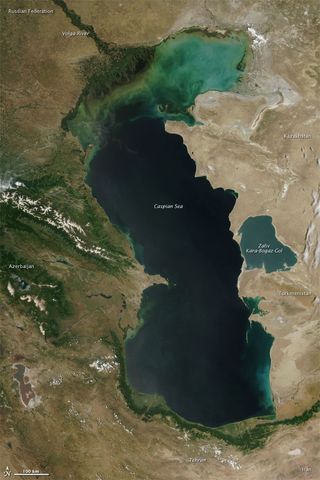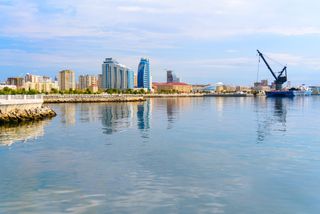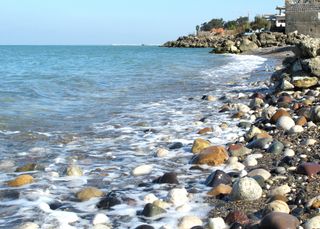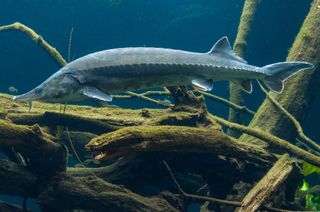Caspian Sea: Largest Inland Body of Water

The Caspian Sea is the Earth's largest inland body of water, when measured by surface area. It lies at the junction of Europe and Asia, with the Caucasus Mountains to the west and the steppes of Central Asia to the east. It is bordered by Russia to the northwest, Azerbaijan to the west, Iran to the south, Turkmenistan to the southeast and Kazakhstan to the northeast.
Ownership of the sea's resources is a contentious issue among its surrounding countries. The Caspian Sea is rich with oil and natural gas, making access to it a high-stakes proposition. These complicated socio-cultural and political aspects, as well as the geographic and environmental features, make the Caspian Sea an interesting subject for researchers.
"In some ways, it connects several countries that share no land border and in other ways it serves as buffer between states of different politics and ideologies," said Michael Kukral, author and professor of geography at the Rose-Hulman Institute of Technology in Ohio.
Facts and figures
- Surface area: 143,244 square miles (371,000 square kilometers)
- Maximum depth: 3,363 feet (1,025 meters)
- Average depth: 692 feet (211 m)
- Length: 640 miles (1,030 km)
- Maximum width: 270 miles (435 km)
- Minimum width: 124 miles (200 km)
- Coastline area: 4,237 miles (6,820 km)
- Water volume: 18,761 cubic miles (78,200 cubic km)
- Altitude: 72 feet below sea level (22 m below sea level). The Caspian Depression, a flat, lowland region encompassing the northern area of the Caspian Sea, is one of the lowest points on Earth.

Climate
"The Caspian Sea is located in a dry region of the world," Kukral told Live Science. Nevertheless, during harsh winters its entire northern half can freeze.
There are three distinct regions of the Caspian Sea. "In the north is a low-lying coastal plain, sandy, hot and humid," Kukral said. This area has the shallowest water in the Caspian, about 20 feet (4 to 5 m).
The Middle Caspian plunges in depth to about 620 feet (190 m). The western seabed slopes swiftly while the eastern gradates gently, according to New World Encyclopedia. The shores are hilly.
The Southern Caspian reaches depths of more than 3,300 feet (1,000 m) and holds most of the water. Kukral described the southern shores as lined with "cliffs and outcroppings overlooking the water where Persian elites often built homes."
The Caspian Sea is endorheic, meaning it has no natural outlets. More than 130 rivers flow into the Caspian Sea, according to Natural History Magazine, none of which are in the east. The primary tributary is the Volga River in the north, which provides about 80 percent of the inflowing water. The Ural River, also in the north, and the Kura River in the west, are also significant tributaries. The inflowing fresh water from these rivers dilute the water. Salinity changes from north to south, from 1.0 to 13.5 parts per thousand (ppt), according to Casp Info, a data-management project about the Caspian Sea funded by the European Union. By contrast, the North Atlantic Ocean has a salinity of 37 ppt, according to Encyclopedia Britannica.
Because it has no outflow, the amount of rainfall in the regions of the rivers can greatly impact the water level of the Caspian Sea, according to GRID-Arendal, an environmental information center. Human-constructed dams built during the last two centuries have also changed water levels. Scientists theorize that tectonic movement and sedimentation changes could be other factors. In recent years, climate change has played a major role. More extreme weather patterns have increased rainfall in Russia, which brings more water into the Volga River and Caspian Sea. But scientists have also seen evidence that overall warmer temperatures could cause the Caspian Sea to dry up.
Scientists estimate that human-caused factors, including oil spills, which limit evaporation by covering the water with a thin film, account for 3 to 5 percent of water level variation, according to Natural History Magazine.
There are approximately 50 small, mostly uninhabited islands in the Caspian Sea, according to New World Encyclopedia. Most are in the north, but the largest island, Ogurja Ada, is in the south.
The Caspian Sea is next to the world's largest lagoon, according to Lakepedia. The 6,949-square-mile (18,000 square km) Kara-Bogaz Gol lagoon is on the eastern coast of the Caspian Sea and is separated from it by sand bars. A dam was built between the Caspian Sea and Kara-Bogaz Gol in 1980 but it was removed in 1992 because of the changes it caused to water levels.

A lake or a sea?
Despite its name, the Caspian Sea can be called either a lake or a sea. Kukral refers to it as a lake, as do many scholars. It has historically been considered a sea because of its size and its saline water, but it embodies many characteristics of lakes. Much of the confusion comes because there are no internationally agreed-upon definitions for seas or lakes.
Seas are often defined by connection to the ocean or another sea via salt water, which the Caspian Sea is not. Seas are usually partially enclosed by land, according to the National Oceanic and Atmospheric Administration, but the Caspian Sea is entirely enclosed by land. Seas are typically salt water. While the Caspian Sea is not fresh water, its salty water is diluted by the inflow of fresh water, especially in the north.
The question of whether it is a lake or a sea has political and economic ramifications, wrote Hanna Zimnitskaya in a 2011 Journal of Eurasian Studies article. If the Caspian Sea is a lake, then the United Nations and international law have no control over its waters, she wrote. If it is a sea, international organizations can have input on its use.
This is especially important because its energy resources. "Petroleum resources around and under the Caspian Sea make it an economic natural resource and a political issue of access and ownership," Kukral said.
If the Caspian Sea is a lake, it contains 40 percent of all lake water in the world. "It is the world's largest lake," Kukral said.
History
The Caspian Sea is a remnant of the ancient Paratethys Sea, part of the Tethys Ocean that existed 50 million to 60 million years ago. At that time, the Tethys Ocean was connected to the Atlantic and Pacific oceans, according to WorldLakes.org. Over millennia, continental platforms shifted, and the Tethys Ocean lost its connections to other oceans. Much of it evaporated during hot and dry periods, and eventually the Caspian Sea, the Black Sea and the Aral Sea formed. The Caspian Sea is estimated to be about 30 million years old. The salt water from the Tethys Sea remained and accounts for the Caspian Sea's salinity.
According to the New World Encyclopedia, archaeologists estimate that humans inhabited the area around 75,000 years ago. It is named after the Caspi Tribe, which settled on its southwestern shore. By the 10th century, small oil wells dotted the shores of the Caspian Sea, according to the State Oil Company of Azerbaijan Republic (SOCAR). Europeans learned of the resource-rich area and began traveling to the Caspian Sea to investigate in the 16th century. The first offshore oil well was drilled in 1820. Today, the oil and gas industry is prominent in the area. Other businesses include salt extraction, fishing and tourism along the coasts.
The water level of the Caspian Sea has fluctuated throughout history, according to GRID-Arendal. From the mid-19th to late 20th century, the water level varied by more than 12 feet (3.6 m). In 1977, the Caspian Sea flooded and caused widespread destruction. Since then, several more floods have occurred. Since 1978, the water level has risen almost 7.4 feet (2.2 m), according to the Pars Times.

Ecosystem
The Caspian Sea is known for its biodiversity, Kukral said. It is considered an independent zoogeographical region because of its unique qualities, according to the World Wildlife Fund.
In many areas, the shores are dotted with shallow saline pools in which birds, small fish, crustaceans and invertebrates thrive. Birds are present throughout the year, and many species use the Caspian Sea as a migratory refuge. Nearly 2,000 species and subspecies of animals live in and around the Caspian Sea, according to Casp Info. About 400 of them are endemic to the area, including the Caspian gull, Caspian turn, spur-thighed tortoise, Horsfield's tortoise, Caspian white fish, Caspian salmon and Caspian seal, the only aquatic mammal in the area. Nearby petroglyphs suggest that dolphins and porpoises may have once lived in the Caspian Sea, according to the Smithsonian Institution.
The most famous and financially valuable animal in the region is the beluga sturgeon, sometimes called the European or Caspian sturgeon. The world's largest freshwater fish, the beluga sturgeon is known for its eggs, which are processed into caviar. The majority of the world's beluga caviar comes from the Caspian Sea. This has caused problems with overfishing. Dams have also destroyed much of their spawning grounds, and pesticides used in land agriculture have limited their fertility. The beluga sturgeon is now critically endangered, according to the World Wildlife Fund.
The Volga River Delta in the North Caspian is home to a wide range of endemic or rare aquatic plants, according to the World Wildlife Fund. The vegetation in the Turkmenistan portion of the Caspian shores is considered impoverished. Nevertheless, there are some specialized salt-resistant plants like shrubs and sagebrush.
Threats
The Caspian Sea faces many ecological threats that have ramifications on human residents of the area, flora and fauna, the economy and the overall ecosystem. "Like all international inland bodies of water the questions today are about access, usage, pollutants/water quality and resources," Kukral said.
The intensive oil and gas development in the Caspian region has caused serious water, air and land pollution problems, natural resources depletion, harm to wildlife and plant life, ecosystem disturbance, desertification and loss of biological and landscape diversity, according to Casp Info. Oil spills, waste from onshore industrial and municipal sites and chemicals, untreated sewage and trash carried in from rivers are major causes of land and water pollution. About 1 million cubic meters (264 million gallons) of untreated industrial wastewater is dumped into the Caspian each year, according to the Pars Times.
The rising sea levels have caused flooding, and as the water washes over shoreline oil wells, it carries oil and other pollutants inland. Scientists estimate that the on- and off-shore drilling operations in the Caspian area emit 15 to 20 million tons of CO2-equivalent each year, according to GRID-Arendal. This has led to serious air pollution problems in the area.
The environmental damage has led to serious health problems for residents of the five countries around the Caspian Sea, who ingest pollutants through air, drinking water, food and swimming. According to the Pars Times, Caspian-area Kazakhstan sees four times the rate of blood diseases, tuberculosis and intestinal infections than other parts of the country. Rates of cancer around the Caspian Sea are also higher than average in all five countries. During the Soviet era, the cities of Sumgayit and Baku were heavily industrialized. Today, the sea around these cities is an ecological dead zone. Human stillbirths and miscarriages happen at higher levels than in inland areas.
Addressing any of these problems is extremely difficult because of ownership disputes between the five countries. "Who is responsible to manage the water quality? Five countries share the Caspian Sea but who benefits from the oil? Where are the boundaries or jurisdiction within the lake?" Kukral said. These persistent questions are hard to answer and often undermine efforts at cooperation.
Additional resources
Sign up for the Live Science daily newsletter now
Get the world’s most fascinating discoveries delivered straight to your inbox.
Jessie Szalay is a contributing writer to FSR Magazine. Prior to writing for Live Science, she was an editor at Living Social. She holds an MFA in nonfiction writing from George Mason University and a bachelor's degree in sociology from Kenyon College.
